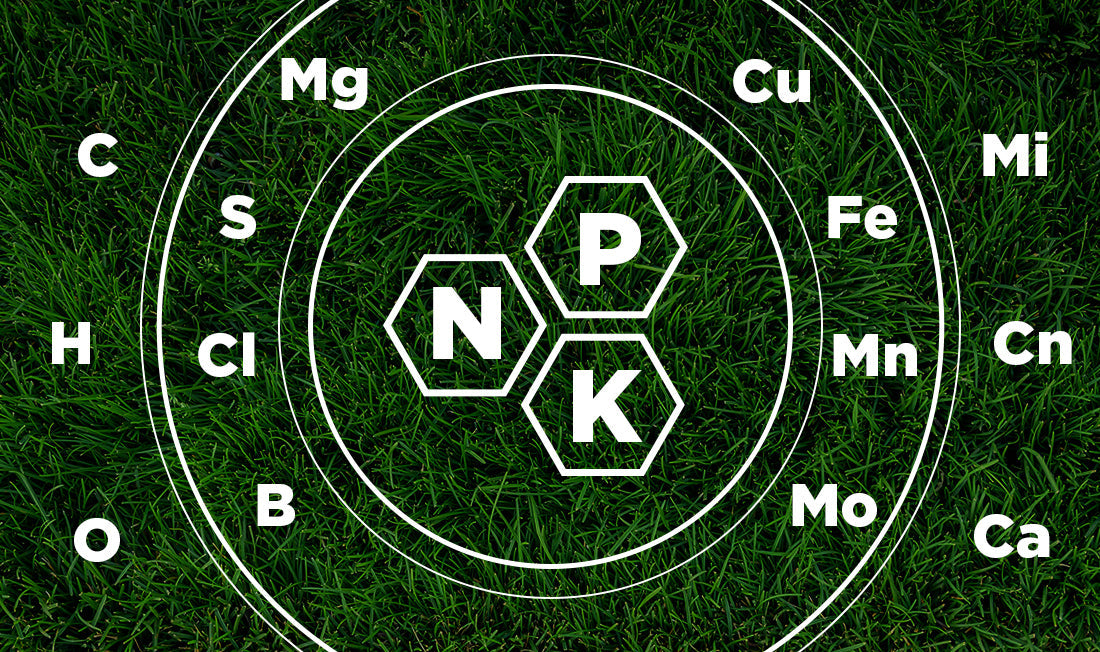Plants require 17 elements necessary to complete their life cycle. These elements can be found in nature, some in the soil, some by air, and some of these elements are more plentiful than others, depending on the environmental circumstances. In this post, we will go over each element and the function it has for plant growth.
Hydrogen (H), Carbon (C), and Oxygen (O)
The first three macronutrients are found in nature, through air and water. These elements do not need to be supplied to plants by humans because of their abundance.
Nitrogen (N)
Plants need Nitrogen in higher amounts to sustain adequate growth. Nitrogen is a component of chlorophyll, amino acids, protoplasts and enzymes in the plant. Nitrogen is a mobile macronutrient in plants, meaning that it can move from different parts of the plant, such as from older leaves to newer leaves. This is why when a Nitrogen deficiency starts, it will often start in the older leaves. When you fertilize your plants with Nitrogen, they may become a darker green than they previously were. This is because there was a deficiency of Nitrogen in the plant. Plants that do not have a Nitrogen deficiency may not exhibit much of a color change. Another symptom of a Nitrogen deficiency is slowed growth because Nitrogen is involved in the growing processes of the plant.
Plants get Nitrogen in nature from decomposed leaves, animals, and other plant matter, aka organic matter. Nitrogen can be absorbed by plants as Ammonium or Nitrate. A suspected Nitrogen deficiency may be hard to capture on a soil test since Nitrogen levels can change rapidly and may be more accurate than testing the plant tissue.
Phosphorus (P)
Phosphorus is a mobile macronutrient, and its availability in soil is related to the soil pH. Phosphorus deficiencies are tough to diagnose by eye because a plant that is deficient in this macronutrient may not be visible. A visible deficiency will present as stunted growth or a dark green to purple coloring, but the best way to tell if there is a deficiency is by a soil test.
Phosphorus is essential to root growth, and plays a role in the storage and transfer of energy.
However, Phosphorus in the soil is relatively immobile which makes it harder for the plant to uptake. While applying Nitrogen fertilizers may result in some substantial visual changes, Phosphorus application results may not be apparent. Even though the visual response of Phosphorus is low, this macronutrient is still very important for plant life.
Potassium (K)
This macronutrient plays several important roles in plants such as regulation of water and energy, opening and closing of the stomata, as well as the transport of nutrients. Potassium is also mobile in the plant. Potassium deficiencies may present as yellow or brown spots on the edges of leaves, but are usually really difficult to distinguish by eye. Likewise, an application of Potassium will typically show little to no visual response.
Potassium and Nitrogen have an important connection, because Nitrogen stimulates rapid soft growth, and Potassium balances this by supporting the growth of firmer tissues. Applications of Potassium without sufficient Nitrogen may lead to decreased Nitrogen content in younger plants.
Chlorine (Cl)
Deficiency symptoms of Chlorine, specifically the chloride ion, are rare, but show as wilting of new leaves, chlorosis, and necrosis. This micronutrient is very mobile in soils. Chlorine plays a role in the stomata functions, osmotic regulations, and maintains a cation/anion balance. Plants are exposed to Chlorine by rainwater, air, irrigation, plant waste, animal manure, and from some fertilizers.
https://irrec.ifas.ufl.edu/irsws/History%20Publications/2/Chen.pdf
Copper (Cu)
Copper is a micronutrient responsible for enzyme activation and is also involved in the chemical reactions for photosynthesis and respiration. A copper deficiency will present in the youngest plant tissue as chlorosis, and there may be a reduction in plant growth. Most soils contain enough Copper for healthy plant growth and a deficiency is rare but can occur in soils that have higher organic matter.
Iron (Fe)
Iron is a micronutrient that is essential for photosynthesis and metabolic processes and if Iron is not present, then chlorophyll cannot be produced. An Iron deficiency may occur in soils that have a pH of over 7.0. As pH increases, the availability of Iron decreases. This micronutrient is not mobile, so a deficiency shows as yellowing of the younger leaves. Iron deficiencies are best to be corrected by foliar application. Iron deficiency is the most common micronutrient deficiency in turfgrass.
Iron toxicity can also occur, and when this happens the turf may turn a very dark green or black color for a few days, but generally there is no permanent damage.
Manganese (Ma)
Most soils contain enough Manganese for plant health, and most deficiencies occur in alkaline soils. Because Manganese is not mobile, a deficiency is seen in the younger leaves. Deficiencies in plants are rare, and this macronutrient is only needed in small amounts.
Molybdenum (Mo)
This micronutrient helps plants to utilize Nitrogen. Plants only need very small amounts of Molybdenum to function. Plants grown in sandy soils with high amounts of rainfall are most likely to show a Mo deficiency, although not commonly.
Nickel (Ni)
Nickel has only been included in the list since the 1990s, and is the element required in very small amounts by plants. Deficiencies are incredibly rare, but Nickel is believed to be involved in Iron metabolism in plants.
Zinc (Zn)
Zinc is involved in enzyme activation and protein breakdown. This micronutrient deficiency will show in various ways depending on the plant such as decreased growth, deformity of leaves, leaf tissue darkening or developing chlorosis. Zinc deficiencies are not common, but can happen in soil with low or high pH levels. Zinc toxicity in plants has been reported as effects of shortening of the roots and chlorosis of the younger leaves.
All of these nutrients are required in some amount for plant life. The best way to figure out what your soil and plants need is to get a soil test and follow soil amendment recommendations based on your grass type and soil type. If you have any questions about your lawn, reach out to our lawn experts and we will help you trouble shoot your lawn!









